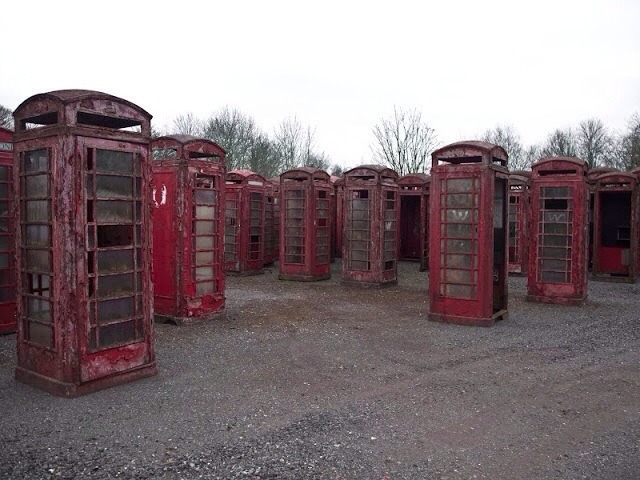UK’s Red Telephone Box Graveyard
These red public telephone boxes once filled the streets of the UK. From the roads of Bermuda to Malta, these telephone boxes stood proudly on almost every street corners of in the UK. When these modernized and brightly colored telephone boxes were invented, they offered the citizens of the UK a convenient way to contact their loved ones at home or in other places in a snap. That is why it’s no wonder why they were loved by the people so much so that in the 1980’s, over 73,000 red telephone boxes were in use. In fact, these telephone box even became one of UK’s most recognizable icon.
Who Invented the Red Telephone Box?
Sir Giles Gilbert Scott was the one who designed the iconic London red telephone box. Scott was an architect who also worked on some of London’s most renowned buildings, such as the Lady Margaret Hall, Cambridge University Library, Liverpool Cathedral, Guinness Brewery Park, and Waterloo Bridge.
The first booth that Sir Giles Gilbert Scott designed was named as the K2 design. Since its creation in 1926, the government of London decided to disperse 1,500 of them on the streets of London. However, just like other new inventions, the first design of the red telephone box encountered some problems. They were too big and weigh almost one ton, that is why authorities couldn’t easily move it around.
Which is why the General Post Office asked Sir Giles Gilbert to redesign the booth and make it lighter. They said that they wanted these new design of booths ready for King George the Fifth’s jubilee celebration. That is why Scott reviewed his original box design and made new ones that are 25% lighter. These new telephone box design made it much easier to transport and reposition in different places. The new design became an instant hit in 1935, and about 20,000 of these new designed red telephone boxes called the K6 was placed all over Britain.
The red telephone boxes became a regular feature in the UK so much so that it could be found on every street corner in London. And by 1992, at least 92,000 red boxes scattered all across the UK.
London Phonebooth and the Effects of New Technology
As cell phones became the popular gadget for making calls, London’s telephone phone booth slowly became more of an eyesore than a convenient way to contact your friends and loved ones. That is why only about one third of the red telephone boxes all over UK were used to make a phone call. Aside from that, these boxes were also expensive to maintain. That is why during the early 2000’s, only about 40,000 booths actually worked. The rest of the were disabled by the British Telecom service.
As red telephone booth’s popularity began to decline, the London phone booth became target for vandalism. Authorities tried a lot of tweaking the design of the booths to prevent vandalism, but not all of them worked. Soon, most of the K6 models telephone boxes were sold off as scrap metal, and the ones that weren’t put out were placed in the Red Box Graveyard.
This telephone boxes graveyard is located in the small village of Carlton Miniott, in the north of England. As years go by, decommissioned red phone boxes are replaced and deposited in this site where hundreds of them are already left to decay.
Redesigned and Repurposed
Transport engineer, Tony Inglis was given the task to decide the fate of these. That is why instead of placing them all in the graveyard and let them die a slow and rustful way, Inglis decided to rebuild some of them and established a business that restores these iconic red boxes.
Inglis was not the only one who wanted to restore and repurpose these red telephone boxes. In fact, other UK citizens got their creativity going and brought these boxes to life. Some redesigned these boxes as mini libraries, coffee and pastry stations, and even a cellphones repair shop. Yes, your read that right, you can get your mobile phone repaired inside a red London phone booth.
Today, there are still about 2,000 K6 telephone boxes scattered on the streets of London.
Interesting Facts About Telephone Booths
- Did you know that the famous red telephone booths were designed to be in the colors green and silver? The Museum of London reports that the original box was supposed to be flashy green and silver – but the Post Office rejected this because it poses a dangerous road hazard. Arguably, the color red made these phone booths so iconic. However, many people commented that they stood out like a sore thumb!
- Did you know the original K2 designs engraved a Tudor crown at the top of the booth for ventilation purposes? K2 design considered comfort as an immediate concern. The original K2 design featured a discreetly pierced Tudor crown as a source of ventilation at the top. By the 1950s, the following design by K6 had made some changes. The crown was made into a removable panel, allowing Scots and British to display their headwear in kiosks.
By M0tty – Own work, CC BY-SA 3.0, https://commons.wikimedia.org/w/index.php?curid=20322020
- Did you know there is a tomb designed like the famous telephone booth? A stroll through the cemetery of St Pancras Old Church may lead you to the majestic and opulent tomb of Sir John Soane. If you look at the resting place of this great neoclassical architect, you might notice a striking resemblance.
- Did you know there are still around 20,000 red telephone booths around the UK? It is worth noting that there had been around a hundred thousand telephone booths before. Amidst this inevitable decline, UK telecoms watchdog Ofcom will revive the telephone booth communications to protect 5,000 boxes. Plans such as putting more telephone booths in accident-prone areas are concrete examples of doing so.
